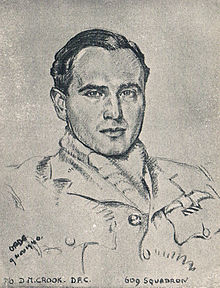David Moore Crook
David Moore Crook | |
|---|---|
Second World War
| |
| Awards | Distinguished Flying Cross |
David Moore Crook,
RAF career
After attending the

Crook was awarded the
On 8 November he was sent on an Instructor's course at the
Flying Spitfire IX EN662 on 18 December 1944 on a high level photographic sortie, Crook was seen to dive into the sea near Aberdeen. He was officially listed as missing in action. When collecting his belongings they found a Bible and a copy of "The Wind in the Willows" by Kenneth Grahame on his bed. A few days earlier he had celebrated his thirtieth birthday.
Memorials
He left a widow, Dorothy Margaret Crook, of
Writings
Crook wrote an autobiographical work about his experiences during the battle entitled Spitfire Pilot, published by
A new paperback edition of his memoir Spitfire Pilot was published by Greenhill Books in October 2021.[8][9] The new edition includes an introduction by the British historian Richard Overy, a Preface by the author's daughter Rosemary Lloyd, and an article by Air Vice-Marshal A F C Hunter, Honorary Air Commodore of the No. 609 (West Riding) Squadron.
References
- ^ "No. 34570". The London Gazette. 15 November 1938. p. 7198.
- ^ "No. 34864". The London Gazette. 4 June 1940. p. 3359.
- ^ "No. 35076". The London Gazette. 14 February 1941. pp. 912–913.
- ^ "No. 34984". The London Gazette. 1 November 1940. pp. 6348–6349.
- ^ "No. 35083". The London Gazette (Supplement). 21 February 1941. pp. 1087–1088.
- ^ "Commonwealth War Graves Commission – Casualty Details". Commonwealth War Graves Commission. Retrieved 21 November 2007.
- ^ "Piece details for AIR 4/21—R.A.F. Pilot's Flying Log Books—Rank and Name: F/Lt. D.M. Crook, D.F.C". The Catalogue. The National Archives. Retrieved 24 June 2009.
- ISBN 9781784387488.
- ISBN 978-1784387488.
Further reading
- Kenneth G. Wynn, Men of the Battle of Britain
